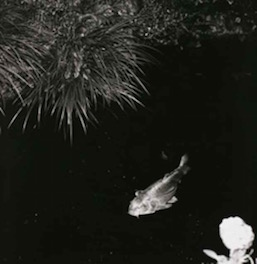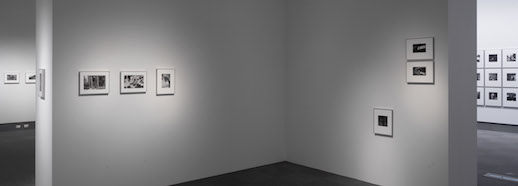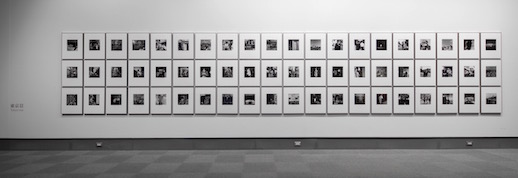Issei Suda’s Journeys of Vision

At heart Suda was a travel photographer – his journeys took us through the wondrous ordinary of our world. In university he joined the Sonne Gruppe, a photography club with an interest in travel. Its influence showed throughout his career, particularly in the series Osoresan e (To Mt. Osore) from 2013. In one image from this journey to a sacred mountain, an elderly woman inspects a pile of garbage. There is nothing remarkable happening here, yet the woman appears to be divining a sacred message. What is it she sees?
Suda worked with a variety of cameras and formats, but was best known for his black and white 6×6 shots taken with a subminiature Minox. He often employed a daylight flash that added a jolting illumination. In one image, a carp emerges out of pitch-black darkness, as if swimming through outer space. In the corners of the frame, pine needles and a white flower burst forth like fireworks. The shot is beautiful and startling, like something bubbling up from the subconscious. Suda referred to this kind of moment as “the collision between the inner being and reality.” It was what he spent his life in search of.
Suda’s work has been said to be about the uncanny within the ordinary, and much of this dualism hinges on quiet quotidian dramas. He honed this eye for drama as a photographer for the avant-garde theater troupe Tenjo Saijiki. Noh theater, which has origins in the animistic Shinto religion, was another influence. A favorite subject was festivals, a time when humans are said to commune with the gods. In one image of a neighborhood festival, a yakuza member wearing only a fundoshi loin cloth and a full-body tattoo of serpents, waves, and kabuki actors balances atop a mikoshi portable shrine. The man is poised to escort the gods to their destination around the block. This 1981 shot comes from ‘Monogusa Syui,’ a series Suda described as a photographic “treasure hunt” of scenes from everyday life. His gaze was always attuned to a “profundity of light” within people, to the dramas unfolding in our world and the subtle moments when something spectacular might take the stage.

The poetic friction between the natural and wild – the artificial and the civilized – is another source of revelation in Suda’s work. One of his most iconic images is of a white goat at night. Struggling to free itself from a rope, it bites down furiously on a vine beside it. The shot looks like it could have been taken in the Garden of Eden. The photo critic Shoji Yamagishi once declared, “It does not resemble a terrestrial animal!” The eerie, rapturous nature of the photograph is enhanced by its dynamic black and white contrast, its skilled framing – the animal’s eye is nearly level with the viewer’s – and its artistic use of ferrotype plating, an expert technique that produces a glazed sheen. The image is from ‘Fushi Kaden,’ the series that put Suda on the map as an art photographer and takes its title from a 14th century treatise on Japanese aesthetics as embodied by Noh theater.
While he photographed scenes all across Japan, Suda held fast to the idea that the most Homeric of journeys are the ones close to home. “There are various forms of travel, but the best type if you wish to enjoy the unexpected is that which can be experienced within walking distance wearing sandals.” Critic Masao Tanaka also recognized Suda’s flaneur sensibility, comparing him to a waki supporting actor in Noh, a role that often takes the form of an itinerate priest. “Freed from the worries of the mundane world, they travel endlessly…Suda moves in close to his subject like an itinerate priest, waiting for the moment when he can sense the invisible aspect that resides within a visible phenomenon.” An artist with the ability to transport the viewer, Suda created work that remains light years beyond and always close to us.



